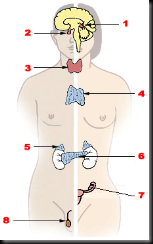Thomas M Barber, Emily Adams, Olaf Ansorge, James V Byrne, Niki Karavitaki and John Wass
T Barber, Department of Endocrinology, OCDEM, University of Oxford, Oxford, United Kingdom
E Adams, Department of Endocrinology, OCDEM, University of Oxford, Oxford, United Kingdom
O Ansorge, Department of Pathology, University of Oxford, Oxford, United Kingdom
J Byrne, Department of Radiology, University of Oxford, Oxford, United Kingdom
N Karavitaki, Department of Endocrinology, OCDEM, University of Oxford, Oxford, United Kingdom
J Wass, Endocrinology, Oxford University, Oxford, OX3 7LJ, United Kingdom
Correspondence: John Wass, Email: john.wass@noc.anglox.nhs.uk
Abstract
Nelson’s Syndrome is a potentially life-threatening condition that not infrequently develops following total bilateral adrenalectomy (TBA) for the treatment of Cushing’s Disease. In this review article, we discuss some controversial aspects of Nelson’s Syndrome including diagnosis, predicitve factors, aetiology, pathology and management based on data from the existing literature and the experience of our own tertiary centre.
Definitive diagnostic criteria for Nelsons’s Syndrome are lacking. We argue in favour of a new set of criteria. We propose that Nelson’s Syndrome should be diagnosed in any patient with prior TBA for Cushing’s Disease and at least one of the following criteria: i) an expanding pituitary mass lesion compared with pre-TBA images; ii) an elevated 0800hrs plasma level of ACTH (>500ng/l) in addition to progressive elevations of ACTH (a rise of >30%) on at least three consecutive occasions. Regarding predictive factors for the development of Nelson’s Syndrome post-TBA, current evidence favours: the presence of residual pituitary tumour on MRI post-TSA; an aggressive subtype of corticotrophinoma (based on MRI growth rapidity and histology of TSA samples); lack of prophylactic neo-adjuvant pituitary radiotherapy at the time of TBA, and; a rapid rise of ACTH levels in year one post-TBA. Finally, more studies are needed to assess the efficacy of therapeutic strategies in Nelson’s Syndrome, including the alkylating agent, temozolomide which holds promise as a novel and effective therapeutic agent in the treatment of associated aggresive corticotroph tumours. It is timely to review these controversies and to suggest guidelines for future audit.




